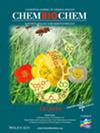封面:开发一种高选择性纳米obret探针来评估活细胞中MAGL的抑制作用(ChemBioChem 6/2025)
IF 2.8
4区 生物学
Q3 BIOCHEMISTRY & MOLECULAR BIOLOGY
引用次数: 0
摘要
组胺亚型3受体(H3R)主要在大脑中表达,在各种神经功能中起关键作用。这张脑显像显示了发光的神经连接,突出了H3R的高表达。接近大脑的分子结构代表了新的正电子发射断层扫描(PET)探针用于精确的大脑成像。光迹显示了PET探针可视化H3R的潜力,提供了对脑功能和病理的深入了解。更多细节可以在研究文章10.1002/ cic中找到。Magnus Schou, Steven H Liang及其同事的202400704。本文章由计算机程序翻译,如有差异,请以英文原文为准。

Front Cover: Development of a Highly Selective NanoBRET Probe to Assess MAGL Inhibition in Live Cells (ChemBioChem 6/2025)
The histamine subtype 3 receptor (H3R) is mainly expressed in the brain, where it plays a key role in various neurological functions. This brain imaging, featuring glowing neural connections, highlights the high expression of H3R. The molecular structure approaching the brain represents new Positron Emission Tomography (PET) probes for precise brain imaging. The light trail indicates the potential of this PET probe to visualize H3R, providing insights into brain function and pathology. More details can be found in Research Article 10.1002/cbic.202400704 by Magnus Schou, Steven H Liang, and co-workers.
求助全文
通过发布文献求助,成功后即可免费获取论文全文。
去求助
来源期刊

ChemBioChem
生物-生化与分子生物学
CiteScore
6.10
自引率
3.10%
发文量
407
审稿时长
1 months
期刊介绍:
ChemBioChem (Impact Factor 2018: 2.641) publishes important breakthroughs across all areas at the interface of chemistry and biology, including the fields of chemical biology, bioorganic chemistry, bioinorganic chemistry, synthetic biology, biocatalysis, bionanotechnology, and biomaterials. It is published on behalf of Chemistry Europe, an association of 16 European chemical societies, and supported by the Asian Chemical Editorial Society (ACES).
 求助内容:
求助内容: 应助结果提醒方式:
应助结果提醒方式:


